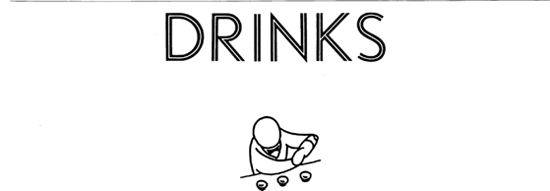

It’s Harry’s Bar—we mustn’t forget; it’s not Harry’s Restaurant. The drinks we serve, the bar itself, the people gathered around it, often in so many layers that they completely block both doorways … these are the essence of the place. Dark-lacquered wood, gray marble, Art Deco ashtrays. A large glass bowl of blood oranges. A huge, beautifully shaped glass carafe in which we still make my father’s martini: a whole bottle of chilled gin and a little vermouth. Stir and pour into 18 glasses and put them in the freezer. When you serve the martini, this glass frosts like no other.
Sit at the bar and watch the bartender make 24 Bellinis for the party upstairs. Bottle after bottle of cold, rosy peach puree, into the cocktail shaker with bottle after bottle of cold Prosecco. Twenty-four Bellini glasses filled with ice, lined up on a tray. Dump out the ice, pour in the rosy Bellini until the glass is full, with a quarter-inch of foam on top. It’s been our most popular drink since my father invented it sometime in the thirties. It didn’t have a name until he christened it in honor of the artist for the big Giovanni Bellini exposition in Venice in 1948.
Tending bar is a fine art, and my father was an artist par excellence. He smiled all the time because he was enjoying what he was doing. At the same time he was effortlessly making one perfect drink after another. Here as elsewhere, simplicity was his trademark. He knew that almost everyone who comes into a bar wants one of the most common drinks—there are perhaps 20 of them—and those are the ones he had at his fingertips. Once in a while a customer would ask for something very esoteric or fancy. He would always say, gently and courteously, “Can you tell me how it is made? Then I can make it for you.”
The basic drinks are simple and are all variations of five kinds of spirits—gin, vodka, rum, whiskey, and brandy—combined with sparkling water, fruit, vermouth, or liqueurs. Most of the drinks we sell are one or another of these combinations.
But people’s tastes do change, and the sales at the bar naturally reflect this. Just as in times of crisis or anxiety people always return to sweet, heavy traditional cooking, so there are moments for certain drinks. Sometimes gin is in; sometimes it’s vodka. Some years people like sweet drinks; sometimes they won’t touch them. Recently there’s been a revival of the classic old sweet liqueurs such as Chartreuse and Cointreau. I can still remember the days when old Mr. Cointreau, well into his eighties, would drink seven or eight of his own liqueurs every day.
It’s important to keep the atmosphere pleasant in a bar. I think that’s easier to do in Italy than in the United States because in the United States people go to bars primarily to drink and perhaps get a little drunk. In Italy it’s a social occasion—to have a drink or two and to see people. Of course, once in a while you’re having such a good time seeing people that you find yourself getting a little drunk.…
But I’m always careful; if anybody drinks too many martinis, I intervene.
My father set a standard for good drinks that we still try to meet. A good drink is very cold and strong enough that you know you’re drinking something. I don’t like it when bars serve a little splash in a big glass—or when they put in too much ice to make it look like more.
To keep drinks from getting watery, we always use large ice cubes instead of the small ones so many people seem to prefer. Ice machines that make large cubes are not so easy to find, but we insist on it. We keep bottles of gin, vodka, and vermouth in the refrigerator and always chill our glasses.
The proportions of a drink are all-important. We have standard proportions for all our drinks—but we also know how to adjust them to please certain customers.
But I think it’s mostly the people—and the atmosphere in the bar—that make our drinks taste so good. People always ask for our drink recipes, and of course I’m giving them to you now, but please don’t expect them to transport you to Harry’s Bar. You’ll have to use a more conventional vehicle for that.
A Tiziano is a Bellini made with grape juice instead of peach puree. It is special grape juice made from uva fragola, the same grapes that are used to make strawberry wine, a local specialty that is not even sold in stores. Use 1 part chilled grape juice to 3 parts chilled Prosecco.
A Mimosa is a Bellini using 1 part freshly squeezed orange juice with a little fresh tangerine juice to 3 parts chilled Prosecco. We used to serve it only in the winter, when Bellinis were out of season.
A Rossini is a Bellini using 1 part fresh strawberry puree to 3 parts chilled Prosecco.